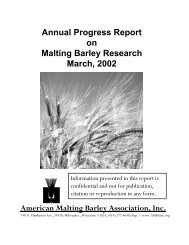Annual Progress Report on Malting Barley Research March, 2007
Annual Progress Report on Malting Barley Research March, 2007
Annual Progress Report on Malting Barley Research March, 2007
Create successful ePaper yourself
Turn your PDF publications into a flip-book with our unique Google optimized e-Paper software.
Missi<strong>on</strong>:<br />
The Cereal Crops <strong>Research</strong> Unit will support public sector barley breeders by providing<br />
the malt quality analyses necessary to assist in making knowledgeable selecti<strong>on</strong>s for<br />
generati<strong>on</strong> of high quality malting barleys.<br />
Primary Objective:<br />
Generate malts from barleys submitted to us from public sector breeders. Analyze the<br />
malts and report the data back to the submitting researcher(s).<br />
Materials and methods:<br />
The methods used for the physical and chemical analyses of micro-malts are, for the<br />
most part, ASBC procedures. Some automated versi<strong>on</strong>s of the standard methods are<br />
used, in which case they have been standardized against the standard ASBC methods.<br />
In order to ensure that the methods used and results produced at CCRU are<br />
representative, we participate in three quality analysis collaboratives comparing our<br />
analyses of comm<strong>on</strong> samples and standards with those of other analytical laboratories.<br />
Micro-malts are prepared with 170 g (dw) samples, if sufficient grain is available.<br />
Smaller samples are used with appropriately modified procedures if sample quantity is<br />
insufficient for the full sample size. The samples are steeped to 45% moisture at 16 ◦ C,<br />
germinated for five days at 17 ◦ C, with intermittent turning and kilned over a period of 24<br />
hours to a final temperature of 85 ◦ C. These c<strong>on</strong>diti<strong>on</strong>s have been shown to produce<br />
malts with quality characteristics similar to commercially prepared malts.<br />
All analytical data and evaluati<strong>on</strong>s of the micro-malts are summarized in individual<br />
reports that are returned to the breeders submitting samples. An evaluati<strong>on</strong> of the<br />
malting quality of selected locati<strong>on</strong>s of the Mississippi Valley Regi<strong>on</strong>al Spring <strong>Barley</strong><br />
Nursery and the Western Regi<strong>on</strong>al Spring <strong>Barley</strong> Nursery are provided to interested<br />
parties. At the end of the analysis year, the results are compiled into two annual<br />
regi<strong>on</strong>al reports. Data from the pre-screen and pilot scale analyses were submitted to<br />
AMBA for collaborative evaluati<strong>on</strong>.<br />
Changes in current funding year:<br />
Pers<strong>on</strong>nel: Mr. Andrew Standish has replaced Mr. D<strong>on</strong>ovan Craig. Andy is a graduate<br />
of the Botany department at the University of Wisc<strong>on</strong>sin – Madis<strong>on</strong>. Andy started work<br />
<strong>on</strong> <strong>March</strong> 5, <strong>2007</strong> and is 100% supported by the AMBA grant over his current 9 m<strong>on</strong>th<br />
appointment.<br />
Equipment: Our very old kiln was replaced with a new versi<strong>on</strong> from Standard Industries<br />
Inc. of Fargo, ND. The new kiln allows us greater c<strong>on</strong>trol and m<strong>on</strong>itoring of kilning<br />
parameters and provides increased sample throughput capabilities.<br />
112
















